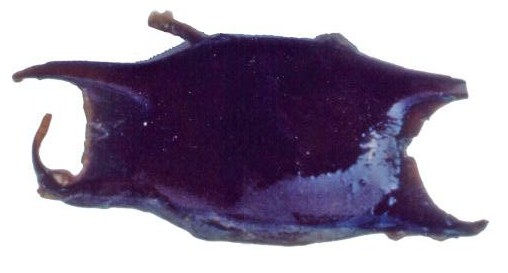Okamejei kenojei
(Bürger in Müller & Henle, 1841)
Ocellate spot skate
Classification: Elasmobranchii Rajiformes Rajidae
Reference of the original description
Systematische Beschreibung der Plagiostomen. Berlin, Veit, pp. 1–200
Systematische Beschreibung der Plagiostomen. Berlin, Veit, pp. 1–200
Image of the original description
.jpg)
Okamejei kenojei (Müller & Henle, 1841)
.jpg)
Okamejei kenojei (Müller & Henle, 1841)
Synonyms / new combinations and misspellings
Dipturus kenojei, Raia fusca, Raia kenojei, Raia porosa, Raja cf. porosa, Raja fusca, Raja japonica, Raja katsukii, Raja kenojei, Raja meerdevoorti, Raja porosa, Raja (Okamejei) fusca, Raja (Okamejei) kenojei, Raja (Okamejei) porosa
Dipturus kenojei, Raia fusca, Raia kenojei, Raia porosa, Raja cf. porosa, Raja fusca, Raja japonica, Raja katsukii, Raja kenojei, Raja meerdevoorti, Raja porosa, Raja (Okamejei) fusca, Raja (Okamejei) kenojei, Raja (Okamejei) porosa
Types
Okamejei kenojei
Lectotype: RMNH: D2499 Paralectotype: RMNH: 4243 RMNH: D2500-2501
Raja fusca
Syntype: USNM: 26542
Raja katsukii
Holotype: ZUMT: 13755;
Raja porosa
Syntype: BMNH: 1874.1.16.61 BMNH: 1874.1.16.60
Okamejei kenojei
Lectotype: RMNH: D2499 Paralectotype: RMNH: 4243 RMNH: D2500-2501
Raja fusca
Syntype: USNM: 26542
Raja katsukii
Holotype: ZUMT: 13755;
Raja porosa
Syntype: BMNH: 1874.1.16.61 BMNH: 1874.1.16.60
Description :
Citation: Okamejei kenojei (Bürger in Müller & Henle, 1841): In: Database of modern sharks, rays and chimaeras, www.shark-references.com, World Wide Web electronic publication, Version 12/2025
Please send your images of "Okamejei kenojei" to info@shark-references.com

Egg capsule of Okamejei kenojei, MTUF 26685, 47.8 x 29.1 mm © Hajime Ishihara, Japan

Egg capsule of Okamejei kenojei, MTUF 26685, 47.8 x 29.1 mm © Hajime Ishihara, Japan
Common names
 Ocellate spot skate,
Ocellate spot skate,  Spiny rasp skate,
Spiny rasp skate,  Swarthy skate
Swarthy skate
 Ocellate spot skate,
Ocellate spot skate,  Spiny rasp skate,
Spiny rasp skate,  Swarthy skate
Swarthy skate
Short Description
Diet: Taean, Korea (data base: 592 specimens): O. kenojei is a bottom-feeding carnivore that consumes mainly shrimp (78.4% of the diet by occurrence, 68.0% of the diet by number, 66.5% of the diet by dry weight, and 90.3% of the diet by IRI; at least 22 shrimp species were identified. Alpheid, pasiphaeid, and penaeid shrimp, including Alpheus brevicristatus, A. digitalis, A. japonicus, Leptochela gracilis, L. sydniensis, Parapenaeopsis tenella, and Trachysalambria curvirostris), fishes (constituting 19.3% of the diet by occurrence, 2.2% of the diet by number, 18.0% of the diet by dry weight, and 3.3% of the diet by IRI. Of the fish prey species found, herring (Clupeidae), anchovy (Engraulidae), sand lance (Ammodytidae), dragonet (Callionymidae), gobid (Gobiidae), croaker (Sciaenidae), and rock fish (Scorpaenidae) were the main prey), and Crabs and amphipods accounted for only 3.0% and 2.4% of the diet by IRI, respectively. Euphausiids, copepods, cumaceans, isopods, and polychaetes constituted less than 1.0% of the diet by IRI. The differences in diet composition between males and females were not significant. The total length (TL) of individuals in this study ranged from 8.2 to 49.0 cm. Cluster analysis based on %IRI (index of relative importance) identified three size classes. Group A (< 20 cm TL) ate primarily caridean shrimp and amphipods; group B (20–30 cm TL) ate exclusively shrimp; and group C (> 30 cm TL) ate penaeoidean shrimp, fishes, and crabs. [13494].
Diet: Taean, Korea (data base: 592 specimens): O. kenojei is a bottom-feeding carnivore that consumes mainly shrimp (78.4% of the diet by occurrence, 68.0% of the diet by number, 66.5% of the diet by dry weight, and 90.3% of the diet by IRI; at least 22 shrimp species were identified. Alpheid, pasiphaeid, and penaeid shrimp, including Alpheus brevicristatus, A. digitalis, A. japonicus, Leptochela gracilis, L. sydniensis, Parapenaeopsis tenella, and Trachysalambria curvirostris), fishes (constituting 19.3% of the diet by occurrence, 2.2% of the diet by number, 18.0% of the diet by dry weight, and 3.3% of the diet by IRI. Of the fish prey species found, herring (Clupeidae), anchovy (Engraulidae), sand lance (Ammodytidae), dragonet (Callionymidae), gobid (Gobiidae), croaker (Sciaenidae), and rock fish (Scorpaenidae) were the main prey), and Crabs and amphipods accounted for only 3.0% and 2.4% of the diet by IRI, respectively. Euphausiids, copepods, cumaceans, isopods, and polychaetes constituted less than 1.0% of the diet by IRI. The differences in diet composition between males and females were not significant. The total length (TL) of individuals in this study ranged from 8.2 to 49.0 cm. Cluster analysis based on %IRI (index of relative importance) identified three size classes. Group A (< 20 cm TL) ate primarily caridean shrimp and amphipods; group B (20–30 cm TL) ate exclusively shrimp; and group C (> 30 cm TL) ate penaeoidean shrimp, fishes, and crabs. [13494].
Distribution
Northwest Pacific: Japan, Korea and Taiwan (Ref. 8630). Appears to be confined tot eh continental shelf off Japan and in the China Seas south to about Xiamen [542]. Source: www.gbif.org
Northwest Pacific: Japan, Korea and Taiwan (Ref. 8630). Appears to be confined tot eh continental shelf off Japan and in the China Seas south to about Xiamen [542]. Source: www.gbif.org
Biology
Oviparous, paired eggs are laid. Embryos feed solely on yolk [733]. Distinct pairing with embrace. Young may tend to follow large objects, such as their mother [17086]. Bottom-dweller that feeds on invertebrates and bony fish.
Oviparous, paired eggs are laid. Embryos feed solely on yolk [733]. Distinct pairing with embrace. Young may tend to follow large objects, such as their mother [17086]. Bottom-dweller that feeds on invertebrates and bony fish.
Remarks
shark-references Species-ID=4310;
shark-references Species-ID=4310;
Parasites (arranged by Jürgen Pollerspöck)
Monogenea
Cestoda
Nematoda
Monogenea
- Rajonchocotyle blandae Sproston, 1946 [17150]
Cestoda
- Acanthobothrium dasybati Yamaguti, 1934 [16129] [16175] [16448] [28741]
- Anthobothrium rajae Yamaguti, 1952 [16129]
Nematoda
- Anisakis simplex (Rudolphi, 1809) [21235]
- Anisakis sp. [21235]
- Pseudanisakis rajae (Yamaguti, 1941) [17029] [14723]
















